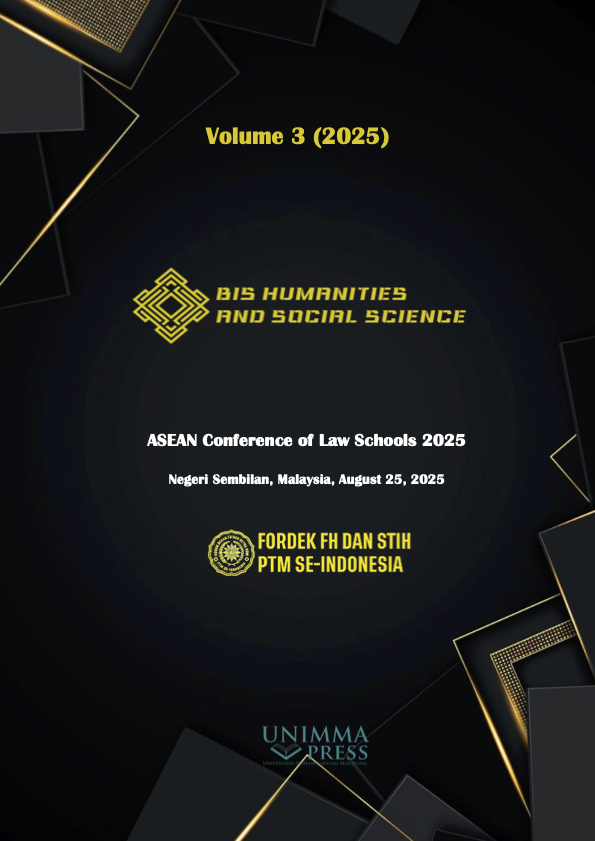Electronic money: Between economic opportunities and legal certainty in Indonesia
Keywords:
Electronic Money, Financial Inclusion, Legal Certainty, Fintech Regulation, Consumer ProtectionAbstract
This article examines the role of electronic money (e-money) in Indonesia as both an economic opportunity and a legal challenge. The widespread adoption of digital financial services such as OVO, GoPay, Dana, and LinkAja has significantly contributed to transaction efficiency, security, financial inclusion, and the growth of micro, small, and medium enterprises (MSMEs). However, the rapid development of financial technology raises critical issues related to data protection, cybersecurity risks, infrastructure disparities, and consumer behavior that tends toward impulsive consumption. Using a normative juridical method, this study analyzes relevant legal frameworks, including the 1945 Constitution, the Information and Electronic Transactions Law, the Consumer Protection Law, and Bank Indonesia regulations, to evaluate the extent of legal certainty and protection for e-money users. The findings indicate that regulatory ambiguities, particularly the overlapping authority between the Financial Services Authority (OJK) and Bank Indonesia, create legal loopholes that undermine consumer protection and hinder innovation. Therefore, regulatory harmonization, stronger enforcement, and improved financial literacy are necessary to ensure that electronic money can support sustainable economic transformation while safeguarding public interests.
References
[1] W. Widayat, I. Masudin, and N. Satiti, “E-Money Payment: Customers’ Adopting Factors and the Implication for Open Innovation,” J. Open Innov. Technol. Mark. Complex., 2020, doi: 10.3390/joitmc6030057.
[2] A. S. Yogananda and I. Dirgantara, “Pengaruh Persepsi Manfaat, Persepsi Kemudahan Penggunaan, Kepercayaan Dan Persepsi Risiko Terhadap Minat Untuk Menggunakan Instrumen Uang Elektronik,” Diponegoro J. Manag., vol. 6, pp. 116–122, 2017.
[3] R. Tazkiyyaturrohmah, “Eksistensi Uang Elektronik Sebagai Alat Transaksi Keuangan Modern,” vol. 3, pp. 23–44, 2018, doi: 10.21154/muslimheritage.v3i1.1240.
[4] B. Foster, Sukono, and M. Johansyah, “Analysis of the Effect of Financial Literacy, Practicality, and Consumer Lifestyle on the Use of Chip-Based Electronic Money Using SEM,” Sustainability, 2021, doi: 10.3390/su14010032.
[5] H. Rathore, “Adoption of Digital Wallet by Consumers,” Ebus. eCommerce eJournal, 2016.
[6] G. Ilieva, T. Yankova, Y. Dzhabarova, M. Ruseva, D. Angelov, and S. Klisarova-Belcheva, “Customer Attitude toward Digital Wallet Services,” Syst., vol. 11, p. 185, 2023, doi: 10.3390/systems11040185.
[7] N. Hidayah, I. Waspada, and M. Sari, “The Dynamics Of Cashless Society: A Systematic Review,” Adv. Int. J. Business, Entrep. SMEs, 2023, doi: 10.35631/aijbes.515002.
[8] “Unlocking the Cashless Revolution: Understanding its Pros and Cons in Transforming University Transactions,” 2023. doi: 10.55057/ijbtm.2023.5.s5.39.
[9] T. M. Griffoli and T. Adrian, “The Rise of Digital Money,” Annu. Rev. Financ. Econ., 2019, doi: 10.5089/9781498324908.063.
[10] S. Usmankhodjaev, J. Zakirov, A. Tashev, and K. Islamov, “The Regulation and Differences between Cryptocurrency, Stablecoin, Central Bank Digital Currency, E-Money, Virtual Currency, and In-Game Currency,” SSRN Electron. J., 2023, doi: 10.2139/ssrn.4384018.
[11] E. A. Sinambela and D. Darmawan, “Strengths and Weaknesses of Using Electronic Money as a Substitute for Cash,” J. Soc. Sci. Stud., 2022, doi: 10.56348/jos3.v2i2.27.
[12] R. H. Karatri, K. T. Fahira, and R. M. Yasin, “The Influence Of Peer To Peer Lending (P2P) And Electronic Money On Increasing Profits Of Micro Small And Medium Enterprises (MSME) In Kudus Regency,” J. Manag. Islam. Financ., 2022, doi: 10.22515/jmif.v2i2.5509.
[13] A. I. Febriyanti, M. I. Anshori, and U. T. Madura, “Using the Qris Bri Mobile Payment Method to Increase Profitability of MSMEs,” Indones. J. Entrep. Startups, 2024, doi: 10.55927/ijes.v2i2.10224.
[14] A. Rasyiddin, E. C. C. Naufal, F. S. Siahaan, and C. Rismanto, “Dampak Sosialisasi Penggunaan E-money Gopay terhadap Pertumbuhan UMKM di perumahan Sudirman Indah Tigaraksa,” J. Ekon. BISNIS DAN Hum., 2024, doi: 10.63494/eksishum.v3i2.102.
[15] V. A. J. M. Silalahi and A. G. D. Tangkudung, “Efisiensi dan Efektivitas Penggunaan Uang Elektronika (E-Money) dalam Inovasi Pengembangan Bisnis,” J. Econ. Bus. UBS, 2024, doi: 10.52644/joeb.v13i2.1579.
[16] I. Ghosh and J. O’Neill, “The Unbearable Modernity of Mobile Money,” Comput. Support. Coop. Work, vol. 29, pp. 227–261, 2020, doi: 10.1007/s10606-020-09373-1.
[17] S. Toapanta, M. Zamora, and L. E. M. Gallegos, “Appropriate Security Protocols to Mitigate the Risks in Electronic Money Management,” pp. 65–74, 2019, doi: 10.1007/978-981-15-0077-0_7.
[18] V. Cherneha, “Classification Of Legal Provisions Regulating Relations, The Object Of Which Is Electronic And Digital Money,” Const. State, 2024, doi: 10.18524/2411-2054.2024.55.311967.
[19] S. Stetsenko, O. Syniavska, M. Shelukhin, S. Lukash, and Y. Barash, “Financial and Legal Regulation of Electronic Money Circulation in Developed Countries,” J. Leg. Ethical Regul. Issues, vol. 22, 2019.
[20] F. Dehghan and A. Haghighi, “E-money regulation for consumer protection,” Int. J. Law Manag., vol. 57, pp. 610–620, 2015, doi: 10.1108/IJLMA-06-2014-0042.
[21] C. P. Shara, “E-Money dalam Kordinasi Pengawasan antara Bank Indonesia dan OJK,” vol. 6, 2021, doi: 10.30596/DELEGALATA.V6I2.5075.
[22] D. Ekawati, T. Tohir, and S. Susanto, “Optimization of Consumer Protection and Increase of Virtual Currency Trading in Indonesia: A Study on Financial Services Authority Regulation,” Al-Ishlah J. Ilm. Huk., 2024, doi: 10.56087/aijih.v27i1.452.
Downloads
Published
Conference Proceedings Volume
Section
License

This work is licensed under a Creative Commons Attribution-NonCommercial 4.0 International License.

